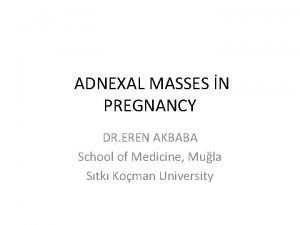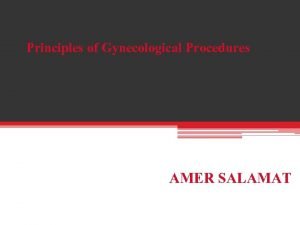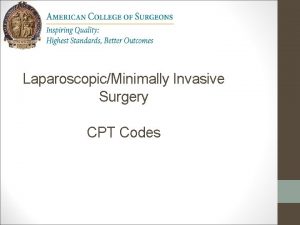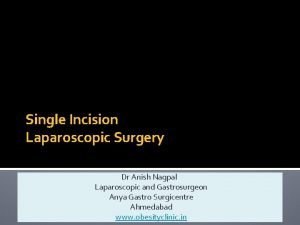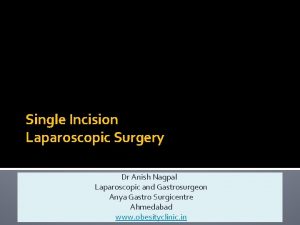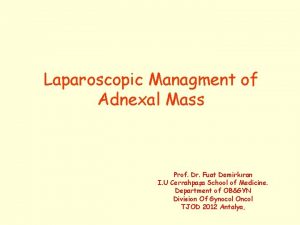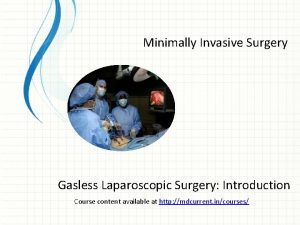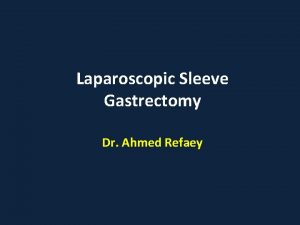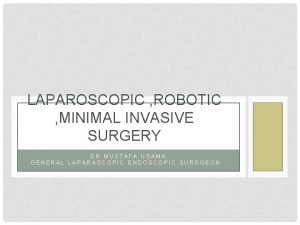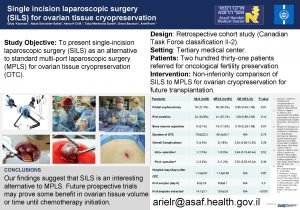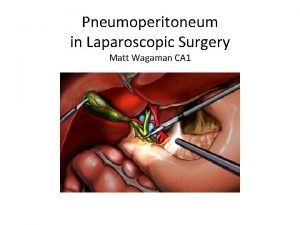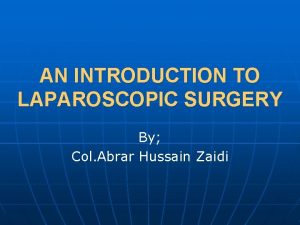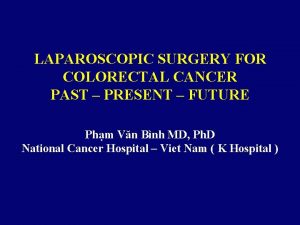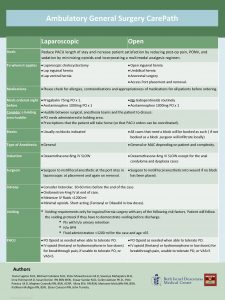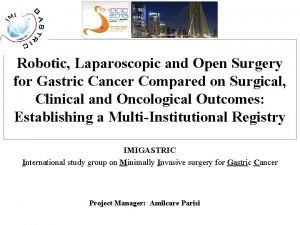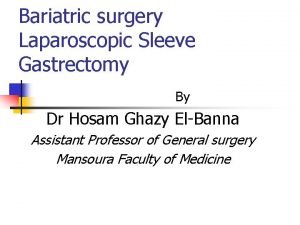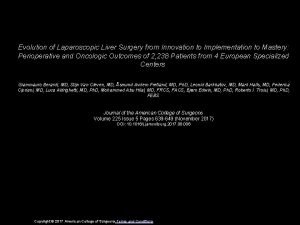Laparoscopic Surgery in Gynaecologic Oncology The suspect adnexal



















- Slides: 19

Laparoscopic Surgery in Gynaecologic Oncology The suspect adnexal mass and ovarian cancer Philippe De Sutter

The adnexal mass Lifetime risk w 5 -10 % of women will undergo surgery for an adnexal mass n 13 – 21 % of these will have an ovarian malignancy w >75% of ovarian cancers are presenting with advanced disease n True stage I(a) is rare w < 1% of apparently benign adnexal masses are “unexpected” ovarian carcinomas w The majority (>95%) of adnexal masses are benign ! Ph. De Sutter Laparoscopic Surgery in Gynaecologic Oncology

Minimal Access Surgery Less invasive … more radical? w Laparoscopic / vaginal surgery w Advantages n n Less blood loss Lower overal morbidity and complications Shorter duration of hospital admission Faster recovery w Disadvantages n n n Ph. De Sutter Longer operative time Longer learning curve Laparoscopic specific complications BMI > 30 -35 Conversion to laparotomy Laparoscopic Surgery in Gynaecologic Oncology

The adnexal mass Laparoscopy versus laparotomy w Systematic review and meta-analysis n n 487 trials – 23 relevant studies Inclusion of only 6 RCT involving 324 cases w Laparoscopy is associated with reduction: n n n Febrile morbidity Urinary tract infection Postoperative pain and complications Days in hospital (-3) Total cost Increased operative time (+11 min) Medeiros, Int J Gynecol Cancer 2008 Ph. De Sutter Laparoscopic Surgery in Gynaecologic Oncology

The adnexal mass Laparoscopic management? w Rupture of an ovarian malignant tumour is a significant prognostic factor and should be avoided w Laparoscopic removal of ovarian cysts should be restricted to patients with preoperative evidence that the cyst is benign Vergote, Lancet 2001 Ph. De Sutter Laparoscopic Surgery in Gynaecologic Oncology

The adnexal mass Laparoscopic management? w Laparoscopic management of adnexal masses: a gold standard? w The surgical diagnosis is the key to adequate management of adnexal tumours w Laparoscopy and gynaecologic cancer: is it still necessary to debate or only convince the incredulous? w The inadequate surgical management performed by laparoscopy as well as by laparotomy may worsen the prognosis of early ovarian cancer w The prognosis of cancer is more related to its biology than to the surgical approach Canis, Sem Surg Oncol 2000 Ph. De Sutter Laparoscopic Surgery in Gynaecologic Oncology

The adnexal mass Preoperative assessment of malignancy w Assess risk of malignancy (index) n n Age (87% > 45 y) Size TV Ultrasonography/ Color doppler / CT / MRI / … CA 125 w Conclusion: n n 1. Obviously malignant 2. Definitely not malignant l l n 3. The “suspect “adnexal mass l l l Ph. De Sutter Non-suspect Benign Not obvious malignant Probably benign … But could be malignant! Laparoscopic Surgery in Gynaecologic Oncology

The adnexal mass Choise … not chance! Benign Obvious benign Expectant management or Laparoscopy Ph. De Sutter Malignant Suspicious Laparoscopy or Laparotomy Laparoscopic Surgery in Gynaecologic Oncology Obvious malignant Gyn Onco and Surgical staging

The adnexal mass Relative value of preoperative assessment w Expert evaluation is not n n Always and everywhere available 100% failure proof w Only final histology is proof that a mass is (not) malignant w Every adnexal mass is considered malignant until proven otherwise by final histology w Management according to the highest probability w Laparoscopic diagnosis is always worthwhile n n n Ph. De Sutter Increased diagnostic power by refined inspection of ovary and peritoneum Avoiding unnecessary laparotomies Choise of incision Laparoscopic Surgery in Gynaecologic Oncology

1 The suspect adnexal mass Laparoscopic procedure w Laparoscopic inspection primary tumour and peritoneum n n Irregular contours / vascularisation Extracystic vegetations / extra ovarian local spread or invasion Peritoneal fluid / ascites Peritoneal metastases w Peritoneal cytology / washing w Complete adnexectomy without tumour / cyst spill n n No puncture, incision, rupture or morcellation Extraction of mass “in toto” through “endobag” l l l Maximum diameter 12, 7 cm Primary 10 mm trocar for cystic mass Colpotomy for large or solid mass w Macroscopy + frozen section Ph. De Sutter Laparoscopic Surgery in Gynaecologic Oncology

The suspect adnexal mass Detection of malignancy w Proceed to immediate surgical staging procedure n Extraovarian spread l n Laparotomy No extraovarian spread l Laparoscopic staging w Patient consent w Oncologic surgeon available w Operating room staff prepared n Ph. De Sutter …. Laparoscopic Surgery in Gynaecologic Oncology

Laparoscopy for a malignant adnexal mass Tumour spill w No spill n Delay of treatment will probably not alter prognosis w Acute spill n Intended / controlled puncture / aspiration l n n Minimal /theoretical contamination Will probably not alter the prognosis If appropriate staging is immediately performed w Chronic spill n unintended capsule rupture / incomplete resection l n May worsen the prognosis l l n Type and amount of spill Upstaging by extra-ovarian spread If appropriate treatment is delayed l Ph. De Sutter Clear / chronic contamination > 8 -17 days Laparoscopic Surgery in Gynaecologic Oncology

Laparoscopy for ovarian cancer Port site metastases w 1% …. 19% w Causes ? n Spread and capture of malignant cells l l n Related to advanced stage, ascites, cyst spill Positive pressure / chimney effect Tissue fragmentation during extraction w Role of preventive measures are unclear n n n "Open" laparoscopy Endobag for tissue extraction Instrument decontamination / Irrigation of ports Low pressure / Gasless laparoscopy / O² Closure of (midline) port incisions w Incisional recurrence also after laparotomy w No necessary negative effect on survival Ph. De Sutter Ramirez, Gynecol Oncol 2003 Abu-Rustrum, Obstet Gynecol 2004 Vergote, Int J Gynecol Cancer 2005 Laparoscopic Surgery in Gynaecologic Oncology

Laparoscopy for ovarian cancer Port site metastases w Review 31 papers / 58 cases w 40 Ovarian cancer n n 83% advanced stage 71% ascites 97% peritoneal carcinomatosis Median time 17 days w 12 Cervical cancer n n 75% therapeutic laparoscopy Median time 5 months w 4 Uterine cancer n Median time 13, 5 months Ramirez, Int J Gynecol cancer 2004 Ph. De Sutter Laparoscopic Surgery in Gynaecologic Oncology

Laparoscopy for adnexal mass Does size matter? w Size (n= 186) n n 10 -20 cm: 169 (91%) 20 -30 cm: 13 (7%) > 30 cm: 4 (2%) No exclusion for US features or elevated CA 125! w Histology / size n n n Benign: 161 (86, 6%) LMP: 8 (4, 3%) Malignant: 16 (8, 6%) l l 10 cm (10 -36) 22, 5 cm (10 -40) 10, 2 cm (10 -28) 10 > CA 125 12 > US+ w avoid 9/10 unnecessary laparotomies Ph. De Sutter Laparoscopic Surgery in Gynaecologic Oncology Ghezzi, BJOG 2008

Laparoscopy for a suspect adnexal mass Surgical management Ph. De Sutter Laparoscopic Surgery in Gynaecologic Oncology 16

2 Laparoscopy versus Laparotomy ? Surgical (re)staging of presumed stage I w Procedure is feasible and surgical outcomes are equal n n n n Inspection of abdominal cavity Peritoneal washings Peritoneal biopsies Contralateral adnexectomy Omentectomy Lymphadenectomy LAV Hysterectomy w Upstaging ~10 -20% w Oncologic safety? Ph. De Sutter Querleu, BJOG 2003 Tozzi, Gynecol Oncol 2004 Leblanc, Gynecol Oncol 2004 Park, Int J Gynecol Cancer 2008 Nezhat, AJOG 2008 Laparoscopic Surgery in Gynaecologic Oncology

3 Laparoscopy for advanced ovarian cancer Assessment of optimal operability w Diagnostic Open Laparoscopy n n Visual assesment by oncologic surgeon Biopsies w Optimal primary debulking surgery possible n Laparotomy Chemotherapy (6 x) w Optimal primary debulking surgery not possible n Chemotherapy (3 x) Interval debulking Chemotherapy (3 x) w Possible advantages n n Ph. De Sutter Avoiding unnecessary laparotomy and delay in chemotherapy Increased succes rate of secundary cytoreductive surgery? Decreased peri-operative morbidity? Selection of chemoresistance? Laparoscopic Surgery in Gynaecologic Oncology

Laparoscopy for a (suspect) adnexal mass Conclusions w Is a pragmatic and therefore standard approach n n n ~100% Se, Sp, NPV Avoid unnecessary laparotomy Benefits of minimal access surgery l Not minimally invasive surgery w Feasible, safe and benificial if : n n Ph. De Sutter Cases are carefully selected Referral if necessary Strict adherence to protocol No delay of appropriate staging procedure if malignancy is detected Laparoscopic Surgery in Gynaecologic Oncology
 Adnexal mass
Adnexal mass Scapus pili
Scapus pili Disadvantages of laparoscopic hysterectomy
Disadvantages of laparoscopic hysterectomy Cpt 49000
Cpt 49000 Race determination from teeth
Race determination from teeth The clothes poem by mongane wally serote
The clothes poem by mongane wally serote Suspect identification
Suspect identification Afwijkende lymfocyten suspect reactief
Afwijkende lymfocyten suspect reactief Question hierarchy
Question hierarchy Từ ngữ thể hiện lòng nhân hậu
Từ ngữ thể hiện lòng nhân hậu Diễn thế sinh thái là
Diễn thế sinh thái là Glasgow thang điểm
Glasgow thang điểm Vẽ hình chiếu vuông góc của vật thể sau
Vẽ hình chiếu vuông góc của vật thể sau Ví dụ về giọng cùng tên
Ví dụ về giọng cùng tên Phép trừ bù
Phép trừ bù Chúa yêu trần thế
Chúa yêu trần thế Lời thề hippocrates
Lời thề hippocrates Hổ sinh sản vào mùa nào
Hổ sinh sản vào mùa nào đại từ thay thế
đại từ thay thế Quá trình desamine hóa có thể tạo ra
Quá trình desamine hóa có thể tạo ra
